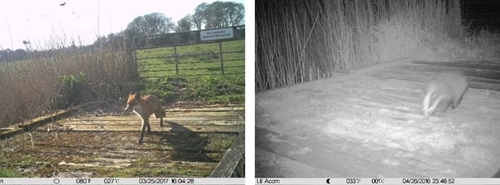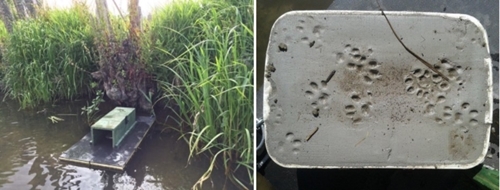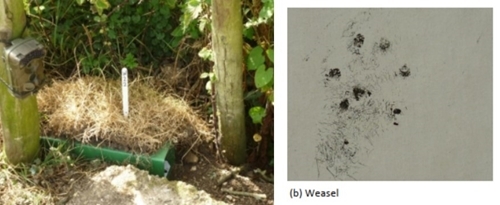Camera Trapping
Each year we deployed 10 camera traps at each hotspot, alternating between 20 paired locations from mid-April to the end of June. The camera traps tell us about the timing and extent of mammalian predator activity on the water meadows. As expected, badgers are a crepuscular or nocturnal visitor with all detections between 6pm and 6am. Foxes also remain predominately active after dark, with the highest proportion of detections at 10-11pm.
However, it is apparent from a small number of detections that foxes are accessing the water meadows during the day, with 6% (70/1209) of detections between 7am and 5pm (see main photo) and hence, foxes need to be considered among the range of predators potentially responsible for day-time predation events. This supports our GPS tracking work which shows similar patterns of water meadow activity.
Our camera traps have also identified bottle necks in the movement of predators with man-made bridges appearing significant to how they navigate this habitat. Future analyses will use our camera trap and nest monitoring data will consider the relationship between fox and badger abundance and lapwing nest survival. This work, alongside other methods of predator monitoring and exclusion within the Waders for Real project, will help wildlife and land managers to develop more effective strategies for increasing lapwing productivity.

For more information on using camera traps for wildlife surveying please see the LIFE Waders for Real Useful Resources page.
Ink-Tracking Tunnels and Mink Rafts
Although our camera traps are effective for larger species such as Foxes and Badgers, they are of limited use for monitoring the presence of smaller wader predators such as stoats, mink and hedgehogs though detections do occur. Ink-tracking tunnels and mink rafts, specific methods developed in-house at GWCT for monitoring these species have been deployed in the valley to collect data on these more elusive predators and compare predator detectability between methods.

Mink Rafts (above left) can be used to detect the presence of mink along river margins and drainage channels. The rafts consist of a buoyant raft base, wooden tunnel and removable clay tracking cartridge. Animals, such as American mink but also water vole and other small mammals leave impressions in this clay pad as they pass through the tunnel (American mink Tracks - above right). This allowed our team to monitor the presence of American mink around our wader hotspot sites. In addition to being an effective monitoring method, once a mink has been detected, this method allows you to set a live capture trap to humanely control this invasive predator.
Clearly, mink rafts show a bias towards semi-aquatic predators, namely American mink and it is this specificity which makes them an effective wildlife management tool. To provide data on terrestrial species, we have also utilised Ink Tracking Tunnels (below left). This technique involves the use of a plastic tunnel, containing a wet-ink pad after which is a white card. As the animal enters the tunnel it steps onto the ink and crosses the paper leaving its footprint (below right). As with camera traps our initial results suggest that tracking tunnels closest to bridges achieved the highest rate of predator detection.

For more information on the use of Mink rafts and Ink-Tracking tunnels please see our LIFE Waders for Real Useful Resources page.